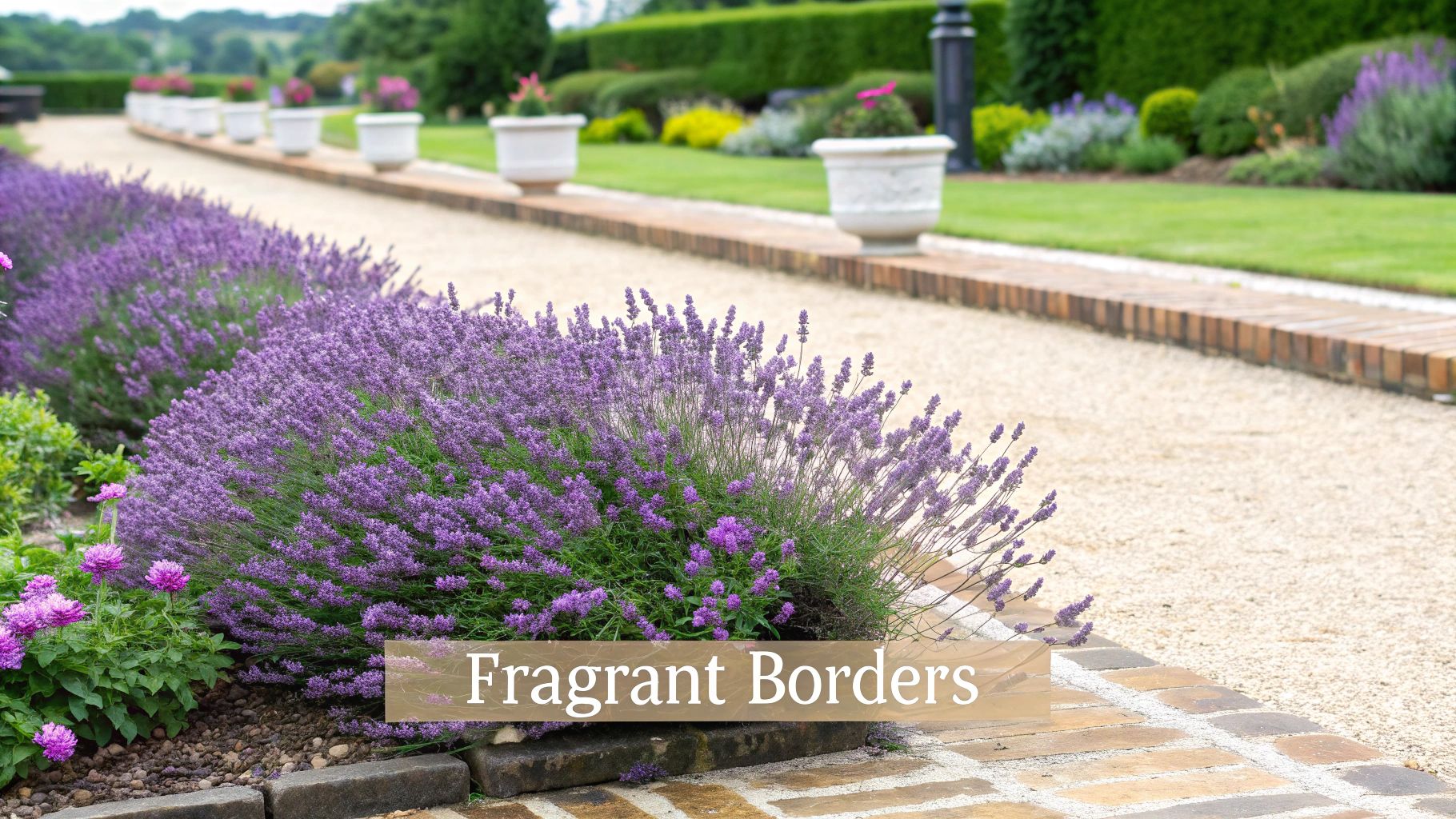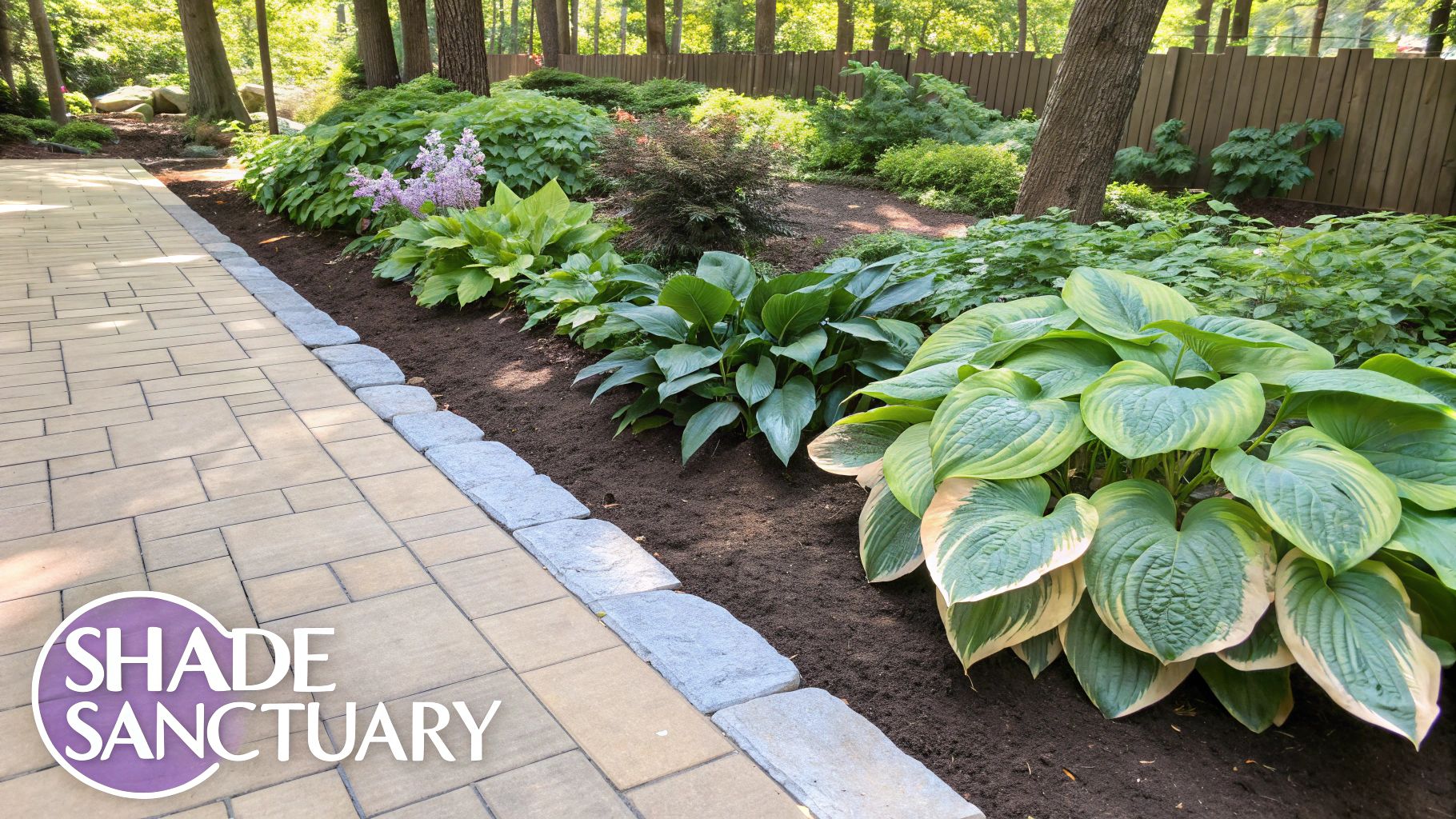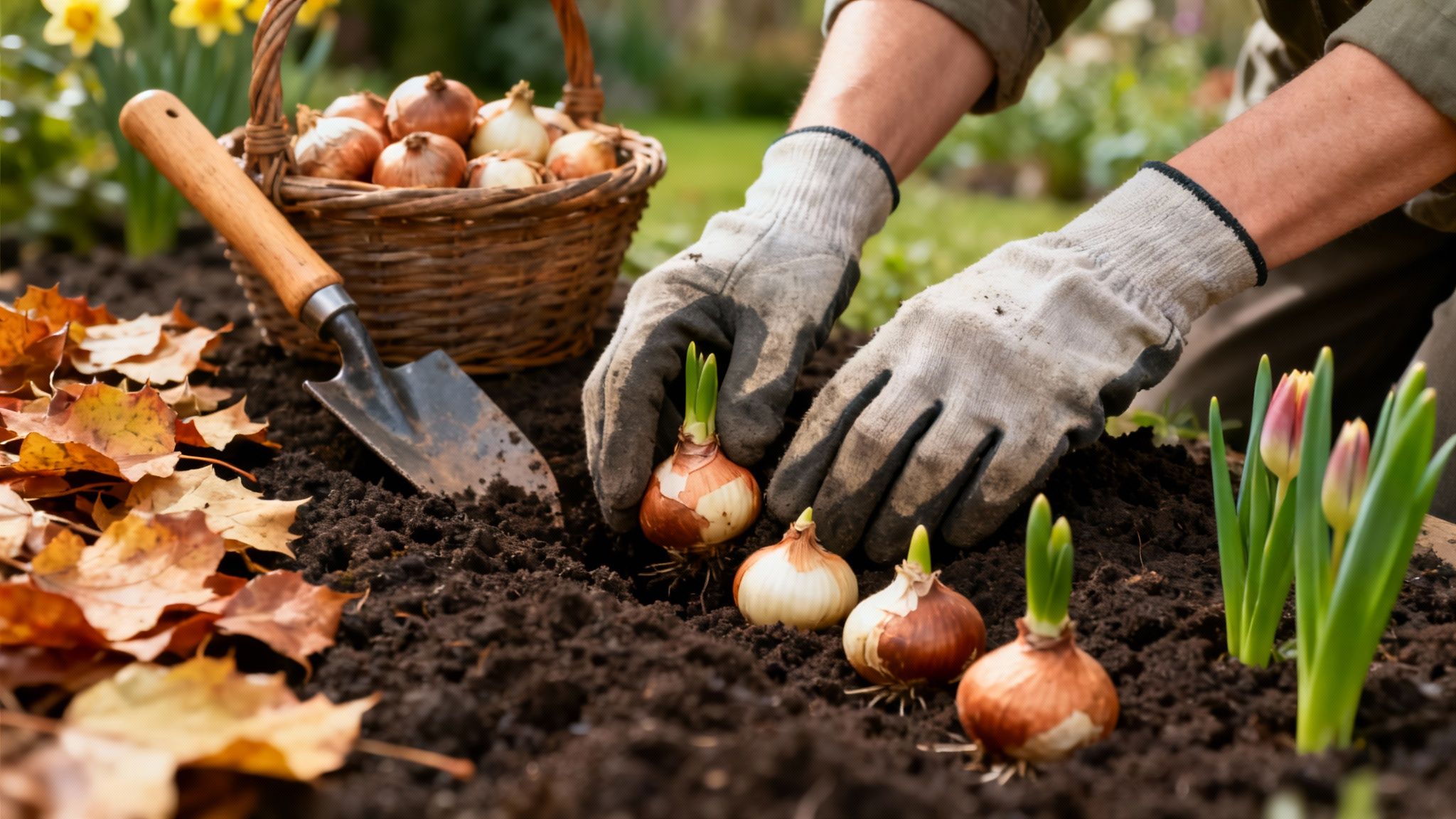A well-designed garden border is like the perfect frame for a masterpiece, defining spaces, creating structure, and providing a canvas for seasonal colour and texture. But choosing the right plants can feel overwhelming. Where do you start? This guide moves beyond the obvious, offering fresh garden border plant ideas to help you create stunning, cohesive, and year-round interest in your beds and pathways.
We'll explore 9 distinct concepts, each packed with specific plant suggestions, practical styling tips, and combinations that work beautifully in UK gardens. Whether you're aiming for a formal, structured look with classic Boxwood, a soft, romantic cottage feel with billowy Catmint, or modern architectural lines using Ornamental Grasses, you'll find actionable inspiration. This isn't just a list of plants; it’s a blueprint for transforming your garden edges into deliberate, beautiful designs.
From the sun-loving Lavender that thrives in dry spots to the shade-tolerant Hosta that brightens dark corners, we provide the insights you need to make confident choices. Forget generic advice. Let's delve into specific, practical strategies to elevate your outdoor space from simple to spectacular, creating borders that are both functional and breathtakingly beautiful.
1. Lavender (Lavandula)
Lavender is a classic and one of the most beloved garden border plant ideas, celebrated for its sensory appeal and structural elegance. This fragrant, evergreen perennial herb forms neat, compact borders with its distinctive silvery-green foliage and aromatic purple flower spikes. It's an excellent choice for creating a low, formal hedge that defines pathways, encloses herb gardens, or lines the front of a sunny flowerbed.

The multi-sensory experience it provides, from its calming scent to the gentle hum of bees it attracts, makes it a truly immersive addition to any garden design. Its resilience and beauty are showcased in famous landscapes like the purple borders of Sissinghurst Castle Garden in Kent and the rustic herb garden perimeters at Château de Villandry in France.
Why It Works for Borders
Lavender excels as a border plant due to its drought tolerance once established, making it a low-maintenance option for hot, dry spots. Its dense growth habit effectively suppresses weeds, and its powerful aroma naturally deters common garden pests like deer and rabbits, protecting more vulnerable plants behind it.
Actionable Planting Tips
- Sun and Soil: Plant in a location that receives at least six hours of direct sun daily. Lavender demands well-draining, slightly alkaline soil; amend heavy clay soils with grit or sand to prevent root rot.
- Spacing for Hedges: For a continuous, dense border, space plants approximately 30-45 cm (12-18 inches) apart. This allows them to grow together without becoming overcrowded.
- Pruning is Key: To maintain a compact shape and prevent woodiness, prune your lavender plants back by about a third after flowering, typically in late August. Avoid cutting into old, bare wood.
- Choosing a Variety: Select a variety suited to your climate. 'Hidcote' and 'Munstead' are hardy English lavenders (Lavandula angustifolia) perfect for the UK climate, offering deep colour and a compact form.
2. Boxwood (Buxus)
Boxwood is the quintessential choice for creating formal, structured garden borders, a timeless classic used for centuries. This evergreen shrub features dense, small-leafed foliage that responds exceptionally well to pruning, making it one of the best garden border plant ideas for creating neat, low hedges and crisp geometric shapes. Its structural integrity provides a strong, year-round 'backbone' to garden designs.

The enduring appeal of Boxwood is evident in the grand formal gardens of the Palace of Versailles, designed by André Le Nôtre, and the intricate parterres at Château de Villandry. It also features prominently in the historic gardens of Colonial Williamsburg and is adapted for minimalist lines in contemporary landscapes, showcasing its remarkable versatility across different design eras.
Why It Works for Borders
Boxwood excels at providing definition and structure. Its dense growth habit creates a solid green wall that can edge pathways, enclose flowerbeds, or form elaborate knot gardens. This evergreen presence ensures the garden's layout remains clear and elegant even in winter, providing a constant framework for seasonal displays of flowering plants.
Actionable Planting Tips
- Soil and Sun: Plant in well-draining soil, as Boxwood dislikes waterlogged roots. A spot with morning sun and afternoon shade is ideal to prevent leaf scorch.
- Keep Roots Cool: Apply a layer of mulch around the base of the plants to help retain soil moisture and keep the root system cool, especially during hot summers.
- Pruning for Shape: The best time to prune is in late spring or early summer, after the first flush of new growth has hardened off. This encourages dense, compact foliage.
- Health Watch: Regularly inspect plants for signs of boxwood blight, a fungal disease. Ensure good air circulation between plants to minimise risk.
For visual guidance on maintaining these classic borders, see the video below on how to trim boxwood hedges.
3. Hostas (Hosta)
For shady spots where other plants struggle, Hostas are unparalleled garden border plant ideas, prized for their dramatic foliage and structural presence. These hardy perennials form lush, mounding borders with leaves that come in an astonishing array of colours, shapes, and textures, from deep blue-greens to vibrant chartreuse and variegated patterns. They are the quintessential choice for defining woodland paths, edging shaded beds, or creating a verdant carpet under trees.

The architectural quality of their leaves provides reliable interest from spring until the first frosts. Their impact is beautifully demonstrated in the extensive hosta collections at Gibbs Gardens in Georgia and within the shaded borders of the Brooklyn Botanic Garden's Shakespeare Garden, showcasing their ability to transform low-light areas into captivating displays.
Why It Works for Borders
Hostas excel as border plants in shady conditions where many flowering perennials fail to thrive. Their dense, overlapping leaves create a living mulch that effectively suppresses weeds, reducing garden maintenance. Their bold foliage provides a strong visual anchor and a perfect contrasting texture for finer-leaved neighbours like ferns and grasses.
Actionable Planting Tips
- Soil and Site: Plant in a location with partial to full shade. Hostas thrive in rich, organic, consistently moist but well-drained soil. Amend poor soils with compost before planting.
- Slug and Snail Defence: Hostas are a favourite of slugs and snails. Apply organic slug pellets in early spring as the leaves emerge, or use copper tape around containers to deter them.
- Division for Health: To reinvigorate plants and manage their size, divide the clumps every 3-4 years in early spring or autumn. This is also an easy way to propagate your collection.
- Choosing a Variety: Select varieties based on your available light. Blue-leaved Hostas like 'Halcyon' need more shade to retain their colour, while variegated ones such as 'Patriot' or gold-leafed 'Sum and Substance' can tolerate more sun.
4. Ornamental Grasses
Ornamental grasses are superb garden border plant ideas, offering a dynamic fusion of texture, movement, and four-season interest. This incredibly diverse group ranges from low, neat tufts to tall, architectural specimens, bringing a modern, naturalistic feel to any planting scheme. They soften hard edges, create a gentle rustling sound in the breeze, and catch the light beautifully, especially in the low sun of autumn and winter.

The work of influential designers like Piet Oudolf, seen in masterpieces such as the High Line in New York and the Lurie Garden in Chicago, has popularised their use. These grasses provide a soft framework for flowering perennials, creating borders that are as stunning in their winter dormancy as they are in summer bloom, offering structure and vital wildlife habitat.
Why It Works for Borders
Ornamental grasses excel at the front of a border because they introduce a completely different form and texture compared to traditional flowering plants. Their upright or arching habits create a visual screen without being a solid block, allowing glimpses of the plants behind. Most are tough, drought-tolerant once established, and require minimal intervention, making them a sustainable and low-maintenance choice.
Actionable Planting Tips
- Timing is Everything: Cut back deciduous grasses in late winter or early spring, just before new shoots appear. This allows their dried forms to provide valuable winter structure and interest.
- Choose Clumpers: For well-behaved borders, select clumping varieties like Miscanthus, Pennisetum, or Molinia. Avoid spreading, rhizomatous types which can quickly become invasive.
- Plant in Drifts: For the most natural and impactful look, plant grasses in groups or drifts of three, five, or more. This creates a cohesive, flowing effect rather than isolated polka dots.
- Mind the Gap: Always consider the mature size of the grass. A small plant can quickly grow to several feet in width and height, so space them accordingly to avoid future overcrowding.
5. Catmint (Nepeta)
Catmint is a wonderfully resilient and hardworking perennial, offering a soft, informal look that contrasts beautifully with more structured plants. Esteemed for its exceptionally long flowering season, it produces billowy clouds of tiny blue, purple, or white flowers above a mound of aromatic, grey-green foliage. This makes it one of the most versatile garden border plant ideas, perfect for creating a relaxed, cottage-garden feel or softening the hard edges of paths and patios.
Its ability to thrive with little fuss has made it a star performer in celebrated gardens, from the sprawling, romantic borders at Hidcote Manor Garden to the pioneering dry gardens of Beth Chatto. The gentle, spreading habit of catmint allows it to elegantly spill over edges, creating a seamless transition from bed to lawn or pathway while buzzing with delighted bees all summer long.
Why It Works for Borders
Catmint is a champion of low-maintenance borders. Once established, it is remarkably drought-tolerant, making it a reliable choice for sunny, exposed sites where other plants might struggle. Its dense, mounding foliage helps to suppress weeds, and its fragrant leaves make it largely resistant to deer and rabbits. The soft texture and cool-toned flowers complement almost any planting scheme, especially classic combinations with roses and geraniums.
Actionable Planting Tips
- Sun and Soil: Plant in a spot that receives full sun to light shade. Catmint is not fussy about soil type but performs best in well-drained soil; it will not tolerate waterlogged conditions.
- Spacing for Effect: For a full, continuous border, space plants approximately 45-60 cm (18-24 inches) apart. This gives them room to arch and mound without becoming overcrowded.
- The 'Chelsea Chop': To encourage a second flush of flowers and prevent the plant from flopping open in the middle, shear it back by about half after its first major bloom, typically in late June.
- Choosing a Variety: 'Walker's Low' is a popular, award-winning variety known for its large size and rich violet-blue flowers. For a more compact and upright border, consider 'Six Hills Giant' or the smaller 'Kit Cat'.
6. Daylilies (Hemerocallis)
Daylilies are the dependable workhorses of the perennial border, celebrated for their resilience, vibrant colours, and graceful, arching form. These reliable plants produce an abundance of showy, trumpet-shaped flowers above mounds of grass-like foliage. Though each flower lasts only a day, a single plant produces so many buds in succession that the display continues for weeks, making them a fantastic choice for a long-lasting, colourful edge.
Their adaptability makes them one of the most popular garden border plant ideas, seen everywhere from the prestigious displays at Longwood Gardens to countless residential borders and even large-scale roadside beautification projects. Their ability to thrive with minimal fuss ensures a rewarding performance year after year, providing structure and a splash of dramatic colour.
Why It Works for Borders
Daylilies are exceptionally tough and adaptable, tolerating a wide range of soil conditions, from heavy clay to sandy loam, and even periods of drought once established. Their dense, arching foliage is excellent for smothering weeds along a border front, creating a clean, low-maintenance edge. The sheer variety of colours and sizes available means there is a daylily for almost any garden design or colour scheme.
Actionable Planting Tips
- Sun and Soil: Plant in a spot that receives at least six hours of sun for the best flowering, although they will tolerate partial shade. They are not fussy about soil but perform best in fertile, well-drained ground.
- Extend the Season: Choose a mix of early, mid-season, and late-blooming varieties to create a continuous flower display from late spring right through to the first frosts.
- Maintenance: Deadhead spent blooms daily by snapping them off at the base. This keeps the plant looking tidy and can encourage more flowers. Divide overcrowded clumps every 3-4 years in spring or autumn to rejuvenate them.
- Choosing a Variety: For a classic, long-blooming choice, 'Stella de Oro' is a compact, repeat-flowering dwarf variety with golden-yellow blooms. For dramatic colour, look for award-winning varieties like the deep purple 'Bela Lugosi'.
7. Spirea (Spiraea)
Spirea is an incredibly versatile and hardworking group of deciduous shrubs, prized as a garden border plant idea for its multi-season appeal and wide range of forms. These shrubs provide a dynamic display, from profuse spring or summer flowers to vibrant summer foliage and rich autumn colour. Varieties range from compact, mound-forming types perfect for low borders, to larger, graceful arching specimens that add structure and presence to mixed shrub beds.
Their adaptability makes them a staple in diverse settings, from the meticulously planned mixed borders at the Arnold Arboretum to countless cottage gardens and suburban foundation plantings across the country. Brands like Proven Winners and Bailey Nurseries have popularised modern varieties with enhanced colour and disease resistance, ensuring there's a spirea for almost any garden scheme.
Why It Works for Borders
Spirea's primary strength lies in its diversity and reliability. Summer-flowering varieties like Spiraea japonica offer long-lasting colour when many other shrubs have finished their display, while their dense, twiggy structure provides winter interest. They are generally unfussy, tolerating a range of soil types and requiring minimal care once established, making them a dependable choice for filling gaps or creating continuous, low-maintenance hedging.
Actionable Planting Tips
- Sun for Flowers: For the most prolific blooming and vibrant foliage colour, plant your spirea in a location that receives full sun. While they can tolerate partial shade, their performance may be diminished.
- Pruning by Type: Timing is crucial. Prune spring-flowering varieties (like S. prunifolia) immediately after they have finished blooming. For summer-flowering types (like S. japonica), prune in late winter or early spring before new growth appears to encourage vigorous flowering.
- Space Correctly: Pay close attention to the mature size listed on the plant label. Space compact varieties 30-60 cm (1-2 feet) apart for a dense border, while larger types may need 1.5 metres (5 feet) or more.
- Choosing a Variety: Select a variety for its specific attributes. 'Goldflame' offers stunning foliage that changes from bronze-red to yellow-green, while 'Anthony Waterer' is a classic choice for its deep pink summer flowers.
8. Sedum (Stonecrop)
Sedum, commonly known as stonecrop, is one of the most resilient and versatile garden border plant ideas, prized for its succulent texture and multi-season appeal. These perennials range from low, creeping groundcovers to taller, upright varieties, all featuring fleshy, water-storing leaves. Their architectural form and late-season flowers make them a superb choice for creating a modern, low-maintenance border in sunny, dry locations.
Popularised by the xeriscaping movement and widely used on green roofs, sedums bring structural interest and attract a host of late-season pollinators. Their robust nature is showcased in the rock garden borders at the Denver Botanic Gardens and in countless pollinator-friendly schemes, proving their value in both aesthetic and ecological garden design.
Why It Works for Borders
Sedum excels as a border plant due to its exceptional drought tolerance and minimal care requirements. Its dense foliage, whether low or upright, effectively smothers weeds and provides a clean, defined edge to beds and pathways. The flower heads emerge in late summer and persist through winter, offering valuable structure and visual interest when much of the garden is dormant.
Actionable Planting Tips
- Sun and Soil: Full sun is essential for strong stems and prolific flowering. Sedums thrive in poor to average, well-draining soil and are highly susceptible to root rot in heavy, waterlogged conditions.
- Avoid Overwatering: As succulents, sedums store water in their leaves and are extremely drought-resistant once established. Water sparingly, only during prolonged dry spells.
- The Chelsea Chop: For taller varieties like 'Autumn Joy' or 'Herbstfreude', perform the "Chelsea Chop" in late May by cutting the stems back by half. This encourages bushier growth and prevents the plant from flopping open later in the season.
- Winter Interest: Leave the dried flower heads and stems standing over winter. They catch the frost beautifully and provide shelter for beneficial insects before being cut back in early spring.
9. Astilbe
Astilbe is a shade-loving perennial that brings vibrant colour and soft texture to the darker corners of a garden. These indispensable plants produce feathery plumes of flowers in shades of pink, red, purple, and white, held aloft on elegant stems above mounds of deeply cut, fern-like foliage. Astilbes are essential garden border plant ideas for creating lush, colourful edges in woodland settings, shady beds, or bog gardens where other plants might struggle.
The plant’s ability to thrive without direct sun makes it a problem-solver for north-facing borders or areas beneath tree canopies. Its graceful structure is showcased beautifully in the renowned shade gardens at Chanticleer Garden in Pennsylvania and the woodland walks at Mount Cuba Center, where they are massed for dramatic effect along pathways and stream banks.
Why It Works for Borders
Astilbe is perfect for borders because it offers both striking flowers and attractive foliage that remains lush all season, providing continuous interest even after the blooms fade. Its clumping habit creates a dense, weed-suppressing edge, and its preference for moist soil makes it an ideal companion for ferns, hostas, and other shade-loving perennials, creating a harmonious and layered planting scheme.
Actionable Planting Tips
- Soil and Moisture: Plant in consistently moist, humus-rich soil. Astilbes will not tolerate dry conditions, so amend your soil with plenty of compost or leaf mould to retain moisture.
- Light Requirements: Astilbe thrives in partial to full shade. While it can tolerate more sun in cooler UK climates, afternoon shade is crucial to prevent leaf scorch.
- Mulching is Essential: Apply a generous layer of organic mulch (such as bark chips or compost) around the base of the plants to help keep the soil cool and moist.
- Division for Vigour: To keep the plants healthy and vigorous, divide the clumps every 3-4 years in the early spring. This also provides an excellent opportunity to propagate your plants and expand your border.
Garden Border Plant Comparison Guide
Bringing Your Border Vision to Life
Creating a truly captivating garden border is a journey, not a final destination. It's a delightful process that merges artistic vision with the practical realities of your garden's unique environment. Throughout this guide, we've explored a versatile palette of plants, from the formal elegance of Boxwood hedges to the soft, hazy textures of ornamental grasses and the vibrant, pollinator-friendly appeal of Catmint. Each of these nine garden border plant ideas offers a distinct personality and a framework for your horticultural creativity.
The most successful borders are born from a clear understanding of fundamental design principles. By now, you should feel more confident in layering plants according to the 'thriller, filler, and spiller' method, creating visual rhythm through repetition, and using contrasting textures and forms to generate year-round interest. Remember the structured silhouette of a dormant Spirea in winter, the architectural seed heads of Sedum in autumn, and the lush, unfurling foliage of Hostas in spring. A dynamic border delivers beauty in every season, not just a fleeting floral display in summer.
Your Actionable Next Steps
Feeling inspired? It’s time to move from planning to planting. Here’s a simple checklist to get you started:
- Assess Your Site: Before you buy a single plant, take a moment to observe your border area. Is it sun-drenched, dappled with shade, or fully shaded? Is the soil well-drained, consistently moist, or prone to drying out? Answering these questions is the single most important step in ensuring your plants thrive.
- Define Your Style: Revisit the ideas presented. Are you drawn to the classic, structured look of Lavender and Boxwood, or does the wilder, more naturalistic feel of Astilbe and ornamental grasses appeal to your aesthetic? Choose a core concept to guide your selections.
- Create a Simple Plan: You don't need a professional landscape design. A rough sketch on paper is enough. Map out where your larger, structural plants (like Spirea or Boxwood) will go first. Then, fill in the gaps with your medium-sized 'fillers' (like Daylilies or Sedum) and finish with your 'spillers' and low-growing ground cover at the front.
- Start Small and Build: Don't feel pressured to complete the entire border in one weekend. Begin with a key section, perhaps focusing on establishing your structural evergreens or a dramatic sweep of a single perennial. You can always add more plants next season as your confidence and budget allow.
Mastering these garden border plant ideas is about more than just a pretty edge. It’s about creating a cohesive, harmonious landscape that frames your home, guides the eye through the garden, and provides a rich habitat for wildlife. It transforms a simple lawn or patio into an immersive, living work of art. So embrace the process, don't be afraid to move a plant if it isn't happy, and enjoy the profound satisfaction of watching your vision take root and flourish.




